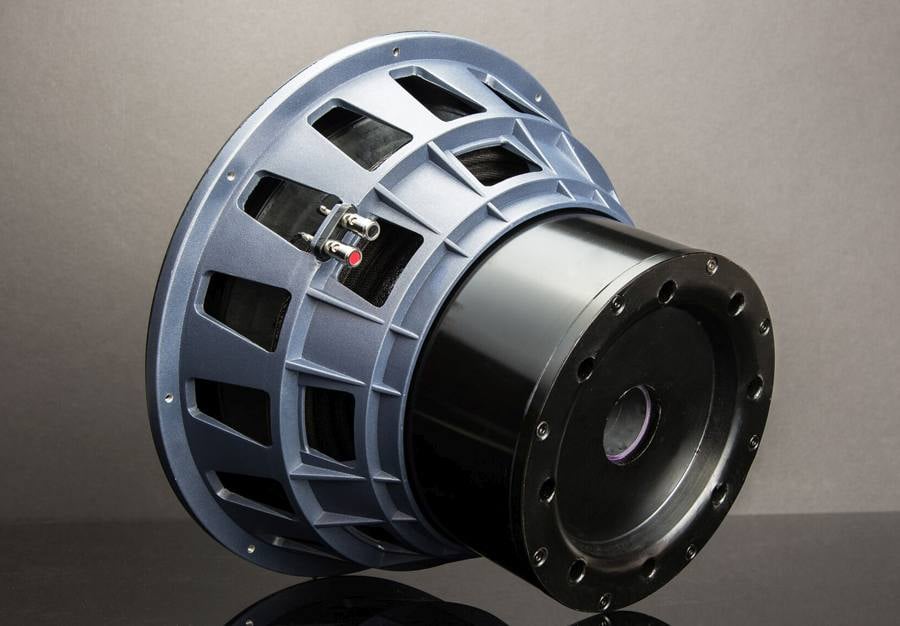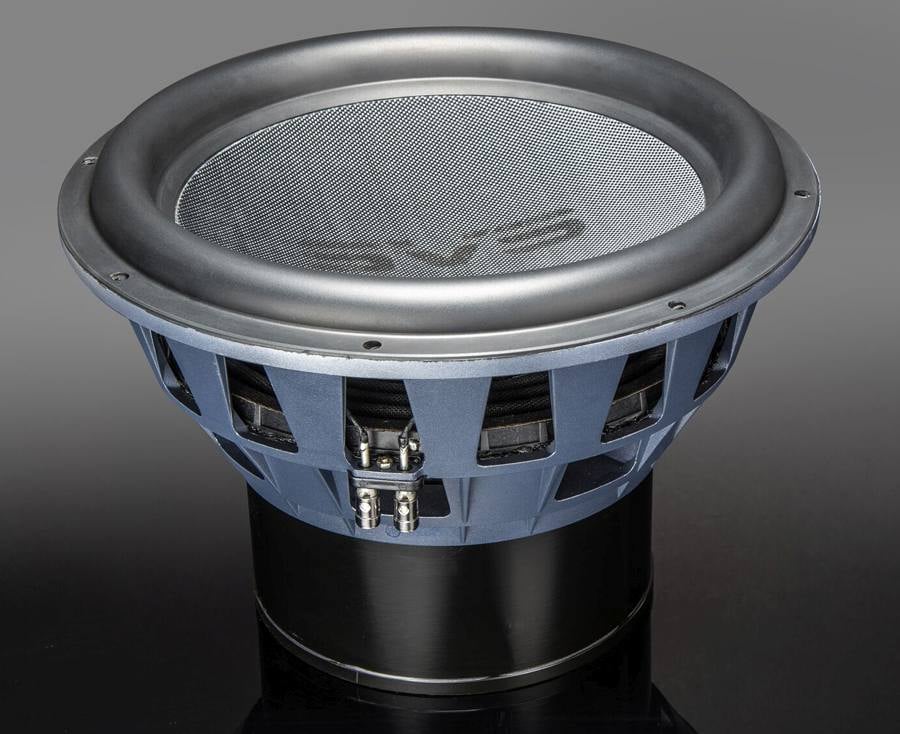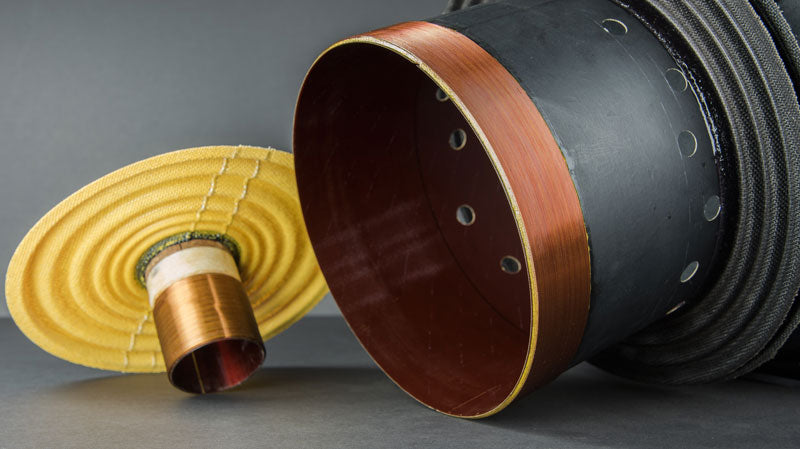Indeed !
We can do this ourselves. With a decent mic that can read the SPL's, without itself distorting, & observing the cone motion with for eg a white mark etc, & software that measures THD as well as FR etc
I don't trust myself to measure excursion by eye. Lots of people say it's easy as pie but I don't trust anything I hear and only half of what I see. Also, unless you are actually measuring the distortion, the amount of acceptable distortion will be very subjective and different for different test signals.
Sure, you can do this, but it will be an estimate at best.
Sure, but they could publish results from several different types boxes for comparison
multiple values of Xmax, each dependent on acoustic load ?
that sounds like a recipe for confusion,
we publish both standards of sensitivity measurement* and every week we get many questions and requests to only show 1 on the spec sheet,
*sensitivity should be shown at nominal 1w/1m, but is often shown at 2.83v regardless of driver impedance because this gives a higher number,
also nominal impedance has a standard, but this if often overlooked by manufacturers who quote what is basically a 5 ohm driver as 8 ohms to allow them to measure sensitivity at higher voltage!
I don't trust myself to measure excursion by eye. Lots of people say it's easy as pie but I don't trust anything I hear and only half of what I see. Also, unless you are actually measuring the distortion, the amount of acceptable distortion will be very subjective and different for different test signals.
Sure, you can do this, but it will be an estimate at best.
very true, you can get an estimate, but it won't be very accurate.
we have correlated to laser measurement, and the error is typically 20%+
lasers are coming down in price, if you don't mind DIY'ing the signal processing you can get a reasonable laser for a couple of thousand dollars these days,
which Klippel test do you refer to as 'performance test'
we use the full suite of Klippel testing to design our drivers, and also advanced FEA tools like Comsol,
Klippel LSI testing is very useful but as you say results are rarely published, this is because they are easy to mis-interpret,
you can also choose the input parameters to either show the driver to be better or worse than it really is,
I'm not a klippel expert, I just know the common test you see published in places like Stereophile is the parameters based test in which the lowest performing category (Bl, Cms/Kms, Le) is the xmax spec. And although I've heard of the performance test - I've never seen one and maybe it is called LSI, I'm not sure.
Regardless, this test doesn't rely on parameter categories, it directly measures total distortion (as I understand it). This is the better test for a spec sheet, if I'm understanding it correctly.
If there are different ways to interpret it, just publish the graph itself.
Originally Posted by gbullimore
multiple values of Xmax, each dependent on acoustic load ?
And THD. Why not, then we'll know the Real capabilities of the drivers, in those instances
very true, you can get an estimate, but it won't be very accurate.
we have correlated to laser measurement, and the error is typically 20%+
I'm very surprised of that figure, especially with a laser !
lasers are coming down in price, if you don't mind DIY'ing the signal processing you can get a reasonable laser for a couple of thousand dollars these day
a couple of thousand dollars What
Originally Posted by just a guy
I don't trust myself to measure excursion by eye.
Not by eye, but with an optical/electronic device. That's on my shortlist as one of my next self designed/builds
i know companies who have tried this, they have a lot of returns from OEM customers for drivers not meeting published specs!No. The pre break in test would never be published anywhere. It would just be used for quality control purposes. The post break in spec would be the one published on the spec sheet.
a batch by batch spec sheet is not what 99.9% of customers are asking for,That's not at all what I said. Test 100 samples from each BATCH and then update the spec sheet for each BATCH.
I would LOVE to buy a driver where the spec sheet continually changes to reflect updated parameters. Just so long as the batch number is clearly labeled on the driver itself, you could look up the spec sheet for the batch number of the driver you have and you would have very accurate specs.
I realize this is a lot further than any company would be willing to go, but it would certainly be ideal for people that can't measure their own t/s.
they want a single spec with tolerance.
most manufacturers are not confident enough in their own product to give a tolerance on the spec sheet,
manufacturers with good production process control will tolerance their parameters and are happy for people to hold them to the spec.
Yes, obviously an enclosure will change things dramatically. But you can just use the klippel standard test baffle since it's already a known reference. If you want to test in multiple different types of enclosures that would be ideal, but again, not something that any manufacturer is going to do.
Yes, the traditional method is still most widely used. But it DOES NOT give an accurate picture of linear excursion. If it did you would not be arguing that this driver has more than 10.5 mm of usable excursion.
there is not a 'klippel standard baffle', the drivers are tested in free air .
if a driver is optimized well to work in small enclosures, klippel Xmax will be lower than a non optimized driver,
in actual life, the optimized driver will throw further and with lower distortion in the enclosure,
thus the measurement giving the incorrect interpretation.
the spec sheet shows 10.5 Xmax, and also give the gap height of 36mm,
from this we can see geometric Xmax 10.5 and max excursion capability of 45.5
those numbers show that the driver is very capable of long throw with a very progressive distortion profile,
Nice. You said you are a design engineer, are you actually working for Peerless?
No. The pre break in test would never be published anywhere. It would just be used for quality control purposes. The post break in spec would be the one published on the spec sheet.
That's not at all what I said. Test 100 samples from each BATCH and then update the spec sheet for each BATCH.
I would LOVE to buy a driver where the spec sheet continually changes to reflect updated parameters. Just so long as the batch number is clearly labeled on the driver itself, you could look up the spec sheet for the batch number of the driver you have and you would have very accurate specs.
I realize this is a lot further than any company would be willing to go, but it would certainly be ideal for people that can't measure their own t/s.
Yes, obviously an enclosure will change things dramatically. But you can just use the klippel standard test baffle since it's already a known reference. If you want to test in multiple different types of enclosures that would be ideal, but again, not something that any manufacturer is going to do.
Yes, the traditional method is still most widely used. But it DOES NOT give an accurate picture of linear excursion. If it did you would not be arguing that this driver has more than 10.5 mm of usable excursion.
And like you said, most people just look at the xmax spec itself, a single number. Most people don't even know that companies are playing around with the traditional formulas to add an extra 1/3 or 1/2 to the xmax rating.
There is ALL KINDS of cheating going on with xmax specs, even from respected companies like B&C. Ideally there should be a standard but in lieu of that, companies can at least define linear excursion as accurately as possible. Coil and gap measurements WILL NOT get you there, especially for this type of driver. You get 10.5 mm, not a number a lot higher that would accurately reflect linear excursion.
And THD. Why not, then we'll know the Real capabilities of the drivers, in those instances
I'm very surprised of that figure, especially with a laser !
a couple of thousand dollars WhatSee below
Not by eye, but with an optical/electronic device. That's on my shortlist as one of my next self designed/buildsThe laser i'll use i already have, & it cost less than $5 new

without a laser, 20% is the typical minimum error,
a reasonable calibrated laser will cost a well over $1000,
a good one will cost $10,000
if you can produce an accurate displacement laser suitable for transducers for even $50 then i'll buy 100 pieces!
i know companies who have tried this, they have a lot of returns from OEM customers for drivers not meeting published specs!
Just tell the customers to break in the driver and it will meet the published specs. OEM customers can't all be that stupid.
a batch by batch spec sheet is not what 99.9% of customers are asking for,
they want a single spec with tolerance.
most manufacturers are not confident enough in their own product to give a tolerance on the spec sheet,
manufacturers with good production process control will tolerance their parameters and are happy for people to hold them to the spec.
Well, I don't disagree that that's what most customers want at this time, but if given the option I think a lot would prefer more accurate batch specs.
Xmax shouldn't be a single number spec anyway, anyone that understands how drivers work knows this. The single number spec and playing to tolerances without updating specs is just making it easier for the lowest common denominator (uneducated customers). But that's the way it is and it ain't going to change anytime soon, so...
there is not a 'klippel standard baffle', the drivers are tested in free air .
Of course they are tested in free air. Are you sure there's not a baffle size specified by klippel? There must be.
the spec sheet shows 10.5 Xmax, and also give the gap height of 36mm,
from this we can see geometric Xmax 10.5 and max excursion capability of 45.5
those numbers show that the driver is very capable of long throw with a very progressive distortion profile,
Those numbers do not show any such thing. You might be able to make a reasonable assumption that Bl MIGHT be capable of long throw with a very progressive distortion profile, but Bl is not the only factor to consider. There's also Cms/Kms (spider surround linearity) and Le linearity to consider and the coil and gap measurements don't even hint at what those limits might be.
For example if the spider won't move past 20 mm there's no way in hell that you're going to get 45 mm of usable excursion, it's just not possible.
But klippel will give you the right answer.
About batch specs - I bought eight Tang Band w6-1139 si drivers second hand but unused. I think they were from the first batch of si ever produced. The t/s I measured were not even close to the published spec even after rigorous break in, for example I measured fs 10 hz higher than the spec sheet. That is a HUGE difference. Batch to batch specs would have solved that little issue, as long as the batch number was clearly labeled on the driver.
It worked out fine for me anyway, I used the drivers in horn designs so the high fs was actually a benefit. But for someone that can't measure t/s, batch to batch variance can ruin a good design.
It worked out fine for me anyway, I used the drivers in horn designs so the high fs was actually a benefit. But for someone that can't measure t/s, batch to batch variance can ruin a good design.
Last edited:
Are any vendors selling these drivers yet?
Gbullimore's post in reply covers it well.
This driver might "only" have a 10.5mm coil overhang but the magnetic gap is very tall. What this means in general is that while the BL may start to drop as the coil moves beyond the coil overhang, it should drop very gradually. The BL variation for subwoofers is typically considered acceptable at 70% per Klippel analysis. With such a tall magnetic gap a 30% loss of BL should not occur until far beyond 10.5mm.
Technically the coil overhang is 10.5mm. As a measure of functional xmax as most other drivers are rated though, this is way conservative. Most other bass drivers are not listing the mathematical coil overhang as the xmax these days.
Need to do some proper testing on this driver before we can draw any conclusions. I doubt Peerless would have engineered a bad driver like this but on the surface kind of looks odd in the traditional sense of course.
Having said that is this a similar driver used in the latest SVS 16 Ultra subs ? Kind of looks similar in construction apart from the diaphragm


No, I don't think they are the same driver.
Just look at the voice coil, there're lots of differences. The biggest difference to me, is that peerless voice coil has much longer height. SVS voice coil, from my rough estimation, is ~32mm height, compared to 57mm for peerless.
https://www.parts-express.com/Data/Default/Images/Catalog/Original/264-1652_ALT_2.jpg

Just look at the voice coil, there're lots of differences. The biggest difference to me, is that peerless voice coil has much longer height. SVS voice coil, from my rough estimation, is ~32mm height, compared to 57mm for peerless.
https://www.parts-express.com/Data/Default/Images/Catalog/Original/264-1652_ALT_2.jpg

Actually I think they are very different drivers, if the picture shown are a real SVS 8 inch voice coil.
32mm winding length is "normal" among subwoofers of different brands. Peerless, Wavecor, ScanSpeak all have subwoofers with similar winding length VCs. To get a reasonable XMAX, manufactures normally use something like 8mm gap height, maybe one or two shorting rings.
57mm winding length with 36mm gap height, on the other hand, is something unusual. I think the magnet arrangement is quite original, with both ends of the gap has stronger BL distrubution. Not unlike a dual gap design.

32mm winding length is "normal" among subwoofers of different brands. Peerless, Wavecor, ScanSpeak all have subwoofers with similar winding length VCs. To get a reasonable XMAX, manufactures normally use something like 8mm gap height, maybe one or two shorting rings.
57mm winding length with 36mm gap height, on the other hand, is something unusual. I think the magnet arrangement is quite original, with both ends of the gap has stronger BL distrubution. Not unlike a dual gap design.

If Zaph's results from a smaller MW166 having a similar motor and spider arrangement are anything to go buy, it won't be pretty:
Zaph|Audio
I have read Zaph`s tests of the Morel 5 and 6" drivers and agree that according to the results (or Zaph`s interpretation of them) this should be horrible drivers.
BUT. something doesent really fit that Picture. In my car i use basically the same drivers. in the dash i have 5" (200hz-3200hz) and in each doors i have dual 6" (50hz-200hz) all are Morel made insert magnet drivers With 75mm voice coils. (the actual drivers are Macrom 59.13 and 59.17)
If i should take Zaph`s comments too heart, it should sound Muddy, sloppy and distorted. but i doesn't, its clean, punchy, linear and distinct. and its not just me and my ears, almost all passengers with a tad of interest in music and sound compliments the clean and clear sound.
I have read Zaph`s tests of the Morel 5 and 6" drivers and agree that according to the results (or Zaph`s interpretation of them) this should be horrible drivers.
BUT. something doesent really fit that Picture. In my car i use basically the same drivers. in the dash i have 5" (200hz-3200hz) and in each doors i have dual 6" (50hz-200hz) all are Morel made insert magnet drivers With 75mm voice coils. (the actual drivers are Macrom 59.13 and 59.17)
If i should take Zaph`s comments too heart, it should sound Muddy, sloppy and distorted. but i doesn't, its clean, punchy, linear and distinct. and its not just me and my ears, almost all passengers with a tad of interest in music and sound compliments the clean and clear sound.
In car is a tough environment to judge. Why do you think lower distortion would sound better?
Actually I think they are very different drivers, if the picture shown are a real SVS 8 inch voice coil.
I wasn't really commenting on motor geometry specifically, more that they have large voice coils, similar venting hole patterns and overall magnet motor structures (visually). I could easily see the SVS driver being made by Tymphany and possibly being the precursor to the STW. Obviously the motors are different.
In car is a tough environment to judge. Why do you think lower distortion would sound better?
I don't, actually what I doubt, are that Zaph`s observations are really that important.
Not only because I like what I hear in my car, but also because the popularity Morel drivers have gained not only in DIY constructions but also with the manufacturers.
- Status
- This old topic is closed. If you want to reopen this topic, contact a moderator using the "Report Post" button.
- Home
- Loudspeakers
- Subwoofers
- New Peerless STW350 subwoofer on the horizon...